On 30 January Kim Jong-un conducted another test launch of what is suspected to be an intermediate-range ballistic missile. This is the seventh event of 2022. With his recent statements implying he is considering ending his self-imposed moratorium on ICBM and nuclear tests, it appears Kim is doubling down on his political warfare and blackmail diplomacy strategy while he simultaneously works to increase his warfighting capabilities. Kim continues to seek his short-term objective of coercing the U.S. and UN into providing sanctions relief, his intermediate objective of driving a wedge in the ROK/U.S. alliance, and his long-term objective of seeking to dominate the Korean peninsula.
It is possible that Kim will continue to escalate his tests in the near to mid-term from the Lunar New Year holiday on 1 February to the birthdays of Kim Jong-il (16 February) and Kim Il-sung (15 April) among other upcoming important dates. He is likely escalating because he is not successfully coercing the ROK, the U.S., and the international community into providing concessions. However, if nations decide to appease him it is very likely that he will judge his strategy as a success and continue to execute from the seven decades old Kim family regime playbook that calls for increased tensions, threats, and provocations to gain political and economic concessions.
Policymakers and strategists continue to be at a loss as to how to stabilize the Korean situation. The proposed courses of action range from military demonstrations to actual operations to a return to “sunshine-like“ policies of twenty years ago. However, there is one course of action that has never been executed with anything more than halfhearted efforts and lip service. While there have been attempts at maximum pressure and maximum engagement neither has employed a holistic, synchronized, and comprehensive information and influence campaign to shape the decision-making, behavior, and attitudes of the elite, the second tier and military leadership, and the Korean people in the North. The U.S. and the ROK/U.S. alliance has never been willing to “lead with influence,” employing sophisticated and well-orchestrated activities to influence multiple target audiences.
While external pressure is important, it is not sufficient to force Kim to change his calculus. The only way he will change course is if he feels internal pressure from the elite and military leadership and they collectively force him to negotiate an end to the nuclear and missile programs in return for the resources necessary for their survival. They must understand their current path is destined to fail and that they must convince Kim to negotiate.
It is assumed they understand this based on the actions of the international community (e.g., sanctions and military readiness of the ROK/U.S. alliance). Unfortunately, life-long indoctrination, the system of social control, and the Propaganda and Agitation Department’s around-the-clock propaganda have been effective in preventing leaders from correctly interpreting the intent and the actions of the ROK, the U.S., and the international community. There has been no effort to compete with the diabolical North Korean social control system and propaganda efforts for the past seven decades.
This has long been an unfortunate missed opportunity because external information is an existential threat to the Kim family regime. This is why Kim Yo-jong coerced the ROK into passing the anti-leaflet law in December 2020 by threatening and then actually destroying the ROK liaison building in Kaesong. Escapees/defectors from the North have been working diligently for years to try to send information into the north and expose the people to the outside work. As Dr. Jung Pak has often asked, who does Kim fear more: The U.S. or the Korean people in the North? The fact is it is the people armed with information about the outside world and South Korea in particular.
The U.S. must take the lead in establishing an aggressive information and influence activities campaign. This is problematic given the view of the current South Korean administration which seeks to engage the regime and refrain from “upsetting” it as evidenced by the anti-leaflet law.But the U.S. and the international community can no longer wait for the ROK to get on board though perhaps the next president will understand the nature, objectives, and strategy of the regime and be willing to partner on an influence campaign. After all, South Korea is the key to any successful outcome on the Korean peninsula.
A comprehensive plan requires nation-level planning, organization, and execution. It will require national leadership to make this a priority, but it should not be feared as resource-intensive or expensive. A wide range of tools, processes, capabilities, and platforms are already in place. They need to be harnessed, synchronized, and employed to meet the influence objectives.

Image of North Korean Road-Mobile ICBM. Image Credit: Creative Commons.
The most important objective is to undermine the legitimacy of the Kim family regime and drive the elite and military leadership to influence Kim Jong-un to negotiate in the belief that it is the only path for regime, elite, and military survival. Kim must fear the loss of internal control if he fails to negotiate a deal that will ensure survival. Kim is actually in a position of significant weakness with COVID mitigation measures that have closed the borders, the recent natural disasters, the poor fall harvest, diversion of resources to nuclear and missile development, and UN and U.S. sanctions. Kim has decided to exploit COVID by implementing draconian population and resources control measures to further oppress the population to prevent any kind of popular resistance. His strategy must be exposed not only to the international community but to the Korean people who suffer at the hands of his policy decisions. The seven missile events of 2022, so far, may be a sign that Kim must ‘externalize” his problems to divert attention from the internal contradictions of the regime. This must be exploited.
The overall influence activity is to recognize, understand, expose, and attack regime strategy. The major theme should be built on the fact that it is Kim Jong-un’s decision-making that is responsible for the suffering across North Korean society from the elite to the general population. His political warfare strategy of subversion, coercion, extortion, and blackmail diplomacy combined with the development of warfighting capabilities to provide him with the option to use force to dominate the peninsula must be understood, explained, and exposed. The condition Kim requires for success is the “divide to conquer” effort – divide the ROK/U.S. alliance to conquer the ROK. It is imperative that every action Kim takes to weaken the alliance results in visible ROK and U.S. efforts to strengthen it. This must be exploited.
While the regime accuses the U.S. of having a hostile policy it is the regime’s own hostile policy, to include the intent to subvert South Korea and dominate the peninsula under the Guerrilla Dynasty and Gulag State that must be consistently transmitted to target audiences inside and outside North Korea. There must be a constant refrain from officials that it is the north that harbors the hostile policy, not the U.S. This must be exploited.
Finally, Kim Jong-un must deny the human rights of the Korean people to remain in power. One of the great many human rights abuses identified in the 2014 UN Commission of Inquiry report is the deliberate isolation of the Korean people and the that they are denied access to information. The international community has a moral obligation to get information into the North. Paradoxically, when the international community focuses on Kim’s nuclear program his legitimacy is enhanced, but when it focuses on his crimes against humanity his legitimacy is undermined. This must be exploited.
The above four objectives should form the foundation for all themes and messages. From these many more supporting messages can be developed and tailored for specific target audiences in the North.
This effort requires an overall organization to orchestrate all influence activities across the instruments of national power. Diplomatic, economic, and military activities must be synchronized with the effort to lead with influence. Every action by government agencies must be considered for their influence effects. Common themes and messages must be distributed to all agencies and agency spokespeople and high-level officials up to including the President and his senior advisors must consistently transmit them as a matter of routine. The State Department’s Global Engagement Center should have a dedicated Korea division that connects to all relevant agencies of the U.S. government as well as allies in the region.
The power of the U.S. Global Media Agency which supervises the two most important information conduits into the North, the Korean services of Voice of America (VOA) and Radio Free Asia (RFA), must be harnessed in this effort. Since the mission of these organizations is to provide factual news and explain U.S. policies to foreign audiences, senior U.S. government officials should be interviewed and allowed to explain U.S. government policies on a routine basis and not as an afterthought. U.S. government officials should have more media engagements with VOA and RFA than other media outlets.

North Korean military conducts a “strike drill” for multiple launchers and tactical guided weapon into the East Sea during a military drill in North Korea, in this May 4, 2019 photo supplied by the Korean Central News Agency (KCNA).
U.S. officials at the UN must expose North Korean strategy and activities. They must push back on UN processes that allow North Korea to take a leading role in the UN Disarmament Forum. In addition, the U.S. must expose the Chinese and Russian efforts to facilitate sanctions evasion activities within the UN Panel of Experts. In addition, every UN organization that addresses human rights must hear from U.S. officials about the human rights abuses and crimes against humanity being committed by the regime. No one can be silent on these issues.
There are myriad technological solutions that can contribute to effective influence. These include penetrating internal networks and indigenous social media platforms as well the existing nearly 5 million smartphones in the hands of many of the people in the north. In addition, communications capabilities and devices could be developed for use by the people in the North.
One of the least exploited resources is the escapee or defector community. Among them are key communicators and people with the expertise to advise on relevant and effective themes and messages. A Korean Defector Information Institute should be established to harness the power of these escapees/defectors to effectively communicate with the Korean people in the North.
The above outlines a few of the very basic steps that should be incorporated into a comprehensive influence strategy. Kim’s weakness has provided opportunities for the international community to exploit. If done properly it may create internal pressure for the elite to influence Kim to negotiate. If he does not, these efforts will prepare the information environment for other outcomes that will be favorable to the U.S. and ROK/U.S. alliance.

Image: A Screenshot from KCNA TV.
However, information and influence activities may not be satisfying to officials, the press, and pundits. They will not yield quick results. It would have been better to have invested in such a program years ago. While most will want to focus on the short term it is time to take a long-term view and establish the foundation for influence activities that will achieve effects over time. But to do so will require leadership at the highest levels.
David Maxwell, a 1945 Contributing Editor, is a retired US Army Special Forces Colonel who has spent more than 20 years in Asia and specializes in North Korea and East Asia Security Affairs and irregular, unconventional, and political warfare. He is the editor of Small Wars Journal and a senior fellow at the Foundation for Defense of Democracies (FDD). FDD is a Washington, DC-based, nonpartisan research institute focusing on national security and foreign policy.

